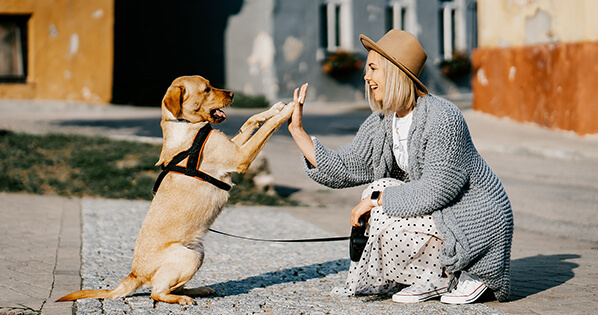
If you are having issues walking your dog, then chances are you might have already tried a multitude of different methods in order to solve this problem. Teaching a dog to walk on a loose leash requires patience from the owner and obedience from the dog. In addition, there are many different ways to train a dog to walk on a loose leash, so the amount of information and techniques that exist can become daunting or confusing.
For this reason, today we bring you a simple blog on how to use the gentle leader appropriately and how to help your dog loose leash walk. Let’s first discuss why the gentle leader is a beneficial tool to your arsenal if you are having issues with walking your dog on leash.
Why Should I Use a Gentle Leader?
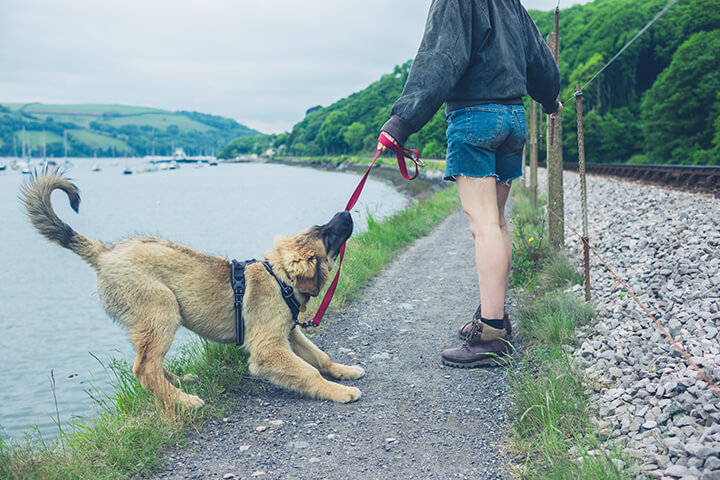
The gentle leader is an extremely beneficial tool that can reduce excessive leash pulling, barking, lunging, and/or jumping. We use the word tool, because it is not a training device we need to use for the rest of eternity with our dog. Instead, a training tool is something we use in order to help reduce a negative or unwanted behavior and replace it with a positive one.
Once walking on a loose leash is re-trained and learned by your furry friend, you can phase the training tool you are using out and go back to using a regular (flat) collar. Therefore, your dog is not stuck with the gentle leader forever! Once they start walking the way you desire, you can start to phase it out, and always come back to it if needed!
Now that we understand what a training tool is, let’s talk about the benefits of this specific tool. The gentle leader fits securely over your dog’s nose, and helps to redirect and refocus your dog. A large issue with leash walking is that the dog’s momentum and intention are all moving forward. Therefore, if they see a dog, person, or something else they want to interact with, all their power can bring them towards it. That is why using a normal collar is not always effective- you cannot redirect your dog’s intention once they get their eyes locked on the object and go into “fixation mode”. Once this mode is entered, the number one tip to snap them out of it is to break their gaze or break the fixation. The problem with a flat collar is that if your dog is powerful and gets into that fixated mode, it is going to be really hard to snap them out of it. Moreover, redirecting the dog with a flat collar can causing choking or uncomfortable pain to your dog, which may further escalate the behavior!
I know what you are thinking, “I don’t use a flat collar to walk my dog, I use a harness and that should help me in this situation, right?” WRONG! A harness is an ineffective tool for leash pulling, because it does not allow you to break their gaze or break the fixation. The same issue that will occur on a flat collar, will also occur on a harness. The only problem is that now they are pulling from their center of gravity, so it is enabling them to gather more power and therefore pull harder. The pulling on the neck deters some dogs when on a flat collar, but the harness lets them avoid that pain and use their whole body to try to move towards what they are fixated on.
The gentle leader is a wonderful tool because it takes this ability to fixate away. Since the headcollar fits over the nose of your dog, when you redirect / correct them, their head turns back to you. This means that a simple leash correction can not only break the fixation, but also break the gaze! By being able to force them to refocus back on you during these instances, you can prevent excessive pulling and get your dog’s full attention.
Being able to redirect your dog’s focus allows you to be able to control his intention. Moreover, the gentle leader prevents unnecessary pressure on the throat (flat collar) and on the chest (harness). It sits high on top of the neck and nose to ensure that it is not causing pain to your fur friend! It also allows ample space around the mouth area (unlike a muzzle) to allow your dog to breath, pant, bark, drink, and take treats!
When Should I Use a Gentle Leader?
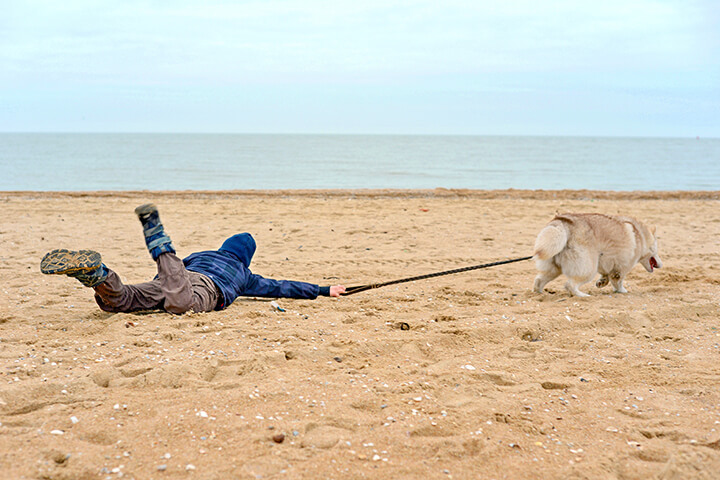
If you are having any of the following issues while walking your dog on a leash, the gentle leader may be a great tool to reduce this negative behavior and replace it with a positive one!
– Excessive leash pulling
– Excessive barking
– Excessive lunging
– Excessive jumping
– Aggression / reactivity to other dogs on leash
– Aggression / reactivity to other humans
Where do I purchase a gentle leader?
The Gentles Leader can be found at most major pet supply stores in the US. These include PetSmart, Petco, and Pet Supplies Plus. Alternatively, you can order one from Chewy or Amazon.
How do I put the gentle leader on?
Using the gentle leader is super easy! Once you get it sized for your dog, you are ready to go. To understand the step by step fitting process, check out this helpful pdf from PetSafe.net!
How Do I Use the Gentle Leader?

Most of the time people have issues with the gentle leader, it is because they do not phase it onto their dog correctly. Let’s walk through the steps in order to get your dog to accept this new training tool as a part of her walk.
1
Putting on the Gentle Leader
The first step to using this tool is to place it on your dog’s nose and clip it securely into place. This may be very easy for you to do, or it may be very difficult. Each dog is going to have a different reaction when placing the gentle leader on for the first time, so stay calm and help coach them through the process. The easiest way to do so is by doing the following:
Ask your dog to sit
Reward the sit with their favorite treat
Repeat 2 to 3 times
Ask your dog to sit and now calmly put the gentle leader on
If they allow you to place the GL on, reward them with a treat
If they do not allow you, calmly hold their collar while you put the GL on
Once you are able to get it on successfully, treat them!
If you are still unable to get the gentle leader on, put them on a leash and stand on it so that they cannot escape or maneuver away
Repeat putting the gentle leader on and taking off 2 to 3 times
Repeat this process for 10 minutes 2 to 3 days total before going to the next step
2
Coaching the Tantrums
You should now be able to put the gentle leader on your dog and take off without much trouble. The next part is all about coaching them through the inevitable tantrums that come when using a device that restricts a dog’s freedom. Your dog most likely will not like the gentle leader at first, because it does not allow them to pull, smell, sniff, fixate, and lead the walk in whatever direction they want. For this reason, COACHING THEM THROUGH THESE TANTRUMS IS THE KEY TO SUCCESS! If they try to shake out of it, seem lethargic, or are whining / barking, it is totally normal. Almost every dog that we train to use the gentle leader goes through this period. The key is being able to get them through it and not giving up during this process. If you throw in the towel during this process, you are going to have a hard time getting your dog to wear a gentle leader again. The reason is that once they throw a tantrum and get what they want from it (removal of the gentle leader), they learn that tantrums get them what they want! This is an issue because every time they have the gentle leader on, they will try to throw a tantrum to get it off. Therefore, if your dog does not like the gentle leader, it is totally normal. Here are some steps in order to coach them through the tantrums and get to the walk:
Ask your dog to sit and place the gentle leader on them
Reward with a treat and some praise
Now clip the leash to the gentle leader but DO NOT go for a walk yet
Calmly stand or sit while your dog wears the gentle leader in place
If they start to scratch at it, cry, bark, or flop on the ground to remove the gentle leader, calmly tell them “Leave it”
If they ignore you, calmly redirect their attention by adding tension to the leash so that they stop their tantrum and look at you
Repeat this for 10 minutes each day for 2 to 3 days before going to the next step
3
Preparing to Walk (The Calming Oval)
You should now be able to put the gentle leader on and off without too much trouble from your pup. In addition, you should be able to coach them through their tantrums by using the simple word association of “leave it”. If you or your dog are struggling with these first two steps, feel free to spend more time on them. Building a strong foundation is the key to success with the gentle leader. If you move too quickly, the tantrums will become too frequent and frustrating on walks.
However, if you have had success with the first two steps, it is time to move on to the walk! The first step is to practice walking somewhere without distraction. This can be inside your home, your apartment, your front yard, or a quiet street. When you are first practicing the walk, start by going in a circle in the same area. This is called a calming oval, and allows the dog to not be distracted by other stimuli, such as new smells, dogs, and cars. The process for starting the calming oval is:
Ask your dog to sit and place the gentle leader on them
Reward with a treat and some praise
Now clip the leash to the gentle leader and begin your calming oval
Walk in a big circle clockwise for 5 minutes, coaching the any tantrums with the simple “leave it” command you have been working on
Now walk counterclockwise for 5 minutes, coaching the tantrums in the same way
Repeat this for 10 minutes each day for 2 to 3 days before going to the next step
4
Going for the Walk
By now, you should be comfortable with getting the gentle leader on and off your dog, coaching the tantrums, and leading the walk without distractions. If any of these steps are giving you issues, feel free to spend a few more days on them. As we said, building the foundation is key to having a successful experience for you and your dog. If you and your dog are having success with the first 3 steps, it is time to move on to the real thing- a normal walk! Most of the rules from the calming oval still apply, but we now must prepare for the distractions. The process to have a successful walk and avoid negative behavior during distractions is:
Ask your dog to sit and place the gentle leader on them
Reward with a treat and some praise
Now clip the leash to the gentle leader and begin with a calming oval
Work your calming ovals for 5 to 10 minutes until your dog is calmed down and beginning to follow your lead
Begin your walk and focus on not allowing your dog to pull or get too far out in front of you. If they start to wander or pull, calmly stop, redirect their focus to you, and ask them to “sit.”
If they sit, calmly regain your position next to them or in front, and then say “ok” to begin the walk again. Feel free to add a word if they are pulling excessively or not listening. We love to use the word “heel” in order to signify that they need to calm down!
If they do not listen to your sit command, ask one more time in a firmer voice. If they still do not listen, calmly push their butt down and put them in a sit. Remember to only ask a command twice, and to put them in it if they do not listen the first time! This will teach them that they cannot get away with blowing you off or not listening to commands.
Continue working on fostering the “loose leash” relationship between you and your dog by not allowing them to get too far ahead. This will help tremendously when a distraction presents itself!
When a distraction does inevitably occur for your dog, there is an easy tactic to deal with it! If it is people, dogs, skateboards, bikes etc., calmly walk your dog to the side of the sidewalk and create space between you and the distraction. Now it is time to get your dog to sit and allow the distraction to pass by. We do not want to keep moving towards it, as it is only going to increase the desire to pull, bark, or lunge. If we allow the dog to do that, then we allow them to rehearse negative behavior, which can become habitual if repeated enough times. Therefore, by pulling your dog off to the side and creating as much space as you need between you and the distraction, you give your dog an opportunity to observe and not react!
If they begin to fixate on the distraction, use a combination of the gentle leader, your legs, and your body to break the fixation. Calmly tell them “leave it” as the distraction passes by and give them constant feedback through the experience.
If they are able to stay relatively calm, and seem to be responding to your “leave it” command, then reward them with a “good boy / girl leave it!” followed by some treats, butt rubs, and / or praise. By doing this, we are rewarding them for being calm and not freaking out about a distraction passing by.
If they are not really able to sit or stay calm, try to increase the distance between you and the distraction. If that still does not work, try to break their gaze completely off the distraction by using your body to block their view. Make sure to use the “leave it “command, even if they are not listening!
If the distraction passes by and you were not able to get them to calm down- do not worry! Calmly tell your dog “heel” and begin your walk again. Not every interaction will be perfect, but by creating space, you give them the opportunity to observe instead of interact! It also allows you to not let them rehearse the negative behavior, and to reinforce the good with a “good boy/ girl leave it!”
This is a great routine to get your dog comfortable walking on a loose leash with the gentle leader! Jumping right into a walk may lead to frustration for you and your dog, so phasing in the training tool is always a great way to seamlessly integrate it into your routine. If you are having issues with your dog hating the gentle leader on not listening at all, check out our guide on the relationship-based training methods we use! In addition, if you are looking for more loose leash walking training, socializing, or basic obedience, feel free to reach out for more help and resources!

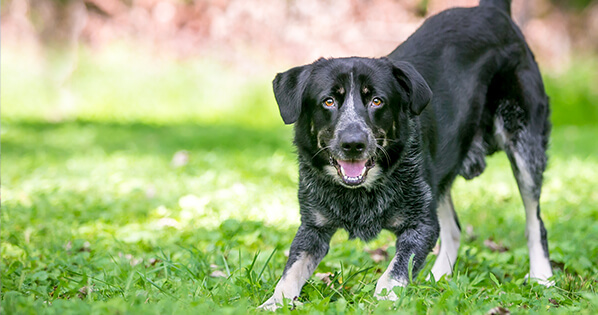
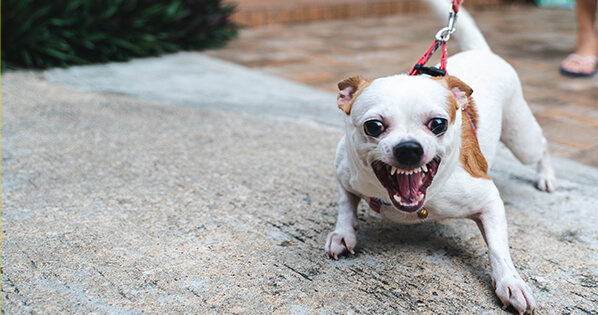
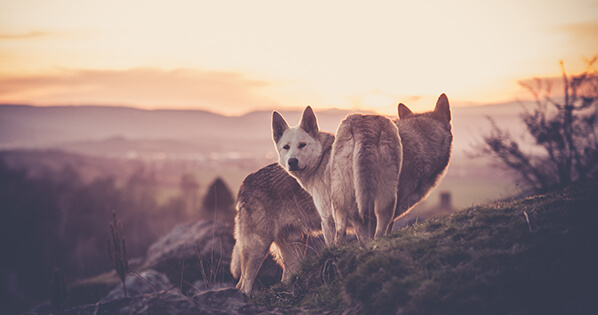
I have been using the Gentle leader off and on with my Pittie mix who is almost 5. She walks beautifully on the GL. If I switch back to harness, the pulling starts again. Is it ok to leave her on it all the time? She is leash reactive to some dogs, but not all. She definitely has a mind of her own!!
Yes, leave it on as long as you need! If it makes the walk enjoyable then use it full time 🙂
You are building good habits this way!
Should I leave the Gentle Lead on all day. Even when we are in the house
No, i would only use it when you are walking!
I and husband have arthritic hands! Your gentle leader is very effective, but the hardware is too small for us to buckle with out great stress to us and the dog!! You need to have larger buckles for back of neck area!!
They have sizes S to XL!
I am sympathetic to your problem. I have neuropathy in my hands and no feeling up to the wrist. The buckle under the neck is so tight that I can’t get it set. Yet we don’t want it so loose that it changes position. I’ve tried to loosen the buckle, with no success. I don’t think they’ve addressed your issue. Just getting a larger size is not a solution in this case.
Can you walk 2 dogs at the same time with them each wearing a gentle leader?
Yes!!!